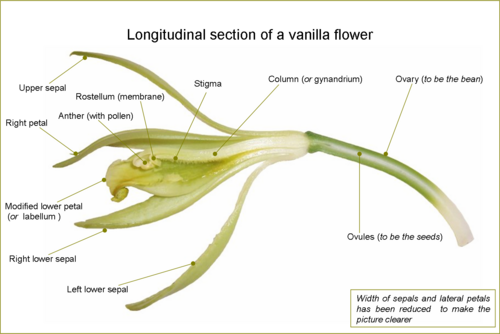Vanilla
2007 Schools Wikipedia Selection. Related subjects: Food and agriculture; Plants
| iVanilla | ||||||||||||||||||
|---|---|---|---|---|---|---|---|---|---|---|---|---|---|---|---|---|---|---|
 Vanilla planifolia
|
||||||||||||||||||
| Scientific classification | ||||||||||||||||||
|
Vanilla is a flavouring derived from orchids in the genus Vanilla. The name came from the Spanish word "vainilla", diminutive form of "vaina" (meaning " sheath"), which is in turn derived from Latin " vagina".
The main species harvested for vanillin is Vanilla planifolia. It is a native of Mexico, though it is now widely grown throughout the tropics. Madagascar is the world's largest producer. Additional sources include Vanilla pompona and Vanilla tahitiensis (grown in Tahiti).
Vanilla is a vine: it grows by climbing over some existing tree, pole, or other support. It can be grown in a wood (on trees), in a plantation (on trees or poles; possibly alternating with rows of sugar cane), or in a "shader", in increasing orders of productivity. If left alone, it will grow as high as possible on the support; every year, growers fold the higher parts of the plant downwards so that the plant stays at heights accessible by a standing human.
The part of the plant in which the distinctive flavoured compounds are found is the fruit, resulting from the pollination of the flower. One flower produces one fruit. Vanilla planifolia flowers are hermaphrodite: they carry both male ( anther) and female ( stigma) organs; however, to avoid self- pollenization (which would tend to result in genetic deficiencies), a membrane separates those organs. Such flowers may only be naturally pollinated by a specifically equipped bee found in Mexico. Growers have tried to bring this bee into other growing locales, to no avail. The only way to produce fruits is thus artificial pollination.
A simple and efficient artificial pollination method was introduced in 1841 by a 12 year-old slave named Edmond Albius on Réunion, then a French colony, in the Indian Ocean. This method is still used today. Using a bevelled sliver of bamboo, an agricultural worker folds back the membrane separating the anther and the stigma, then presses the anther on the stigma. The flower is then self-pollinated, and will produce a fruit. The vanilla flower lasts about one day, sometimes less, thus growers have to inspect their plantations every day for open flowers, a labor-intensive task.
The fruit (a seed pod), if left on the plant, will ripen and open at the end; it will then exhaust the distinctive vanilla smell. The fruit contains tiny black seeds, which, in ripe fruits, carry the vanilla flavour. These black seeds are the tiny black specks found in dishes prepared with whole natural vanilla. Vanilla planifolia seeds will not germinate in normal soil; they need a certain symbiotic mushroom.
Growers reproduce the plant by cutting: they cut off parts of the plants, plant them in the ground and wait for them to grow new roots.
History
Vanilla was a highly regarded flavoring in Pre-Columbian Mesoamerica, and was brought back to Europe (and from there the rest of the world) by the Spanish Conquistadors.
In ancient Mexico the Totonac people were regarded as the producers of the best vanilla. The Totonac are from the region that is now known as the state of Veracruz ( Papantla, Mexico, holds itself out as the origin of vanilla). They continued to be the world's chief producers of the flavoring through the mid 19th century. At that time, French vanilla growers in Mexico traded their knowledge of artificial pollination of flowers for the Totonac knowledge of preparing the beans.
The Coca-Cola Corporation is the world's largest customer of natural vanilla extract. When New Coke was introduced in 1985, the economy of Madagascar crashed, and only recovered after New Coke flopped. The reason was that New Coke used vanillin, a less expensive synthetic substitute, and purchases of vanilla more than halved during this period.
The market price of vanilla rose dramatically in the late 1970s due to a typhoon. Prices stayed stable at this level through the early 1980s due to the pressure of recently introduced Indonesian vanilla. In the mid 1980s the cartel that had controlled vanilla prices and distribution since its creation in 1930 disbanded. Prices dropped 70% over the next few years to nearly $20 USD per kilo. This changed due to typhoon Huddah, which struck early in the year 2000. The typhoon, political instability, and poor weather in the third year drove vanilla prices to an astonishing $500 USD per kilo in 2004. A good crop coupled with decreased demand have pushed the market price down to the $40 per kilo range in the middle of 2005.
Chemistry
Though there are many compounds present in the extracts of vanilla, the compound predominantly responsible for the characteristic flavor and smell of vanilla is known as vanillin (4-hydroxy-3-methoxybenzaldehyde). Another minor component of vanilla essential oil is piperonal (heliotropin). Piperonal and other substances affect the odour of natural vanilla.
Vanilla essence comes in two forms: the actual extract of the seedpods, and the far cheaper synthetic essence, basically consisting of a solution of synthetic vanillin in ethanol. Natural vanilla is an extremely complicated mixture of several hundred different compounds, versus synthetic vanillin which is derived from phenol and is of high purity.
Stages of production
- Step 1: Harvest
The beans are harvested green and immature. At this stage they are odorless.
- Step 2: Killing
The vegetative tissue of the vanilla pod is killed to prevent it from growing further after being harvested. The method of killing the tissue varies, but may be through: (1) sun killing, (2) oven killing, (3) hot water killing, (4) killing by scratching, or (5) killing by freezing.
- Step 3: Sweating
The beans are then held for 7 to 10 days under humid and high temperature (45 º to 65 ºC) conditions, often by placing the beans in fabric covered boxes immediately after boiling. This allows enzymes to process the compounds in the beans into vanillin and other compounds important to the final vanilla flavor.
- Step 4: Drying
To prevent rotting and to lock the aroma in the pods, the beans are then dried, often by laying out in the sun during the mornings and then returned to their boxes in the afternoons. When the bean reaches 25-30% of its weight in moisture (as opposed to the 60-70% it began the drying process with) it has completed the curing process and will exhibit its fullest aromatic qualities.
- Step 5: Grading
When fully cured the vanilla is sorted by quality and graded.
Uses
| 2005 Top Vanilla Producers of the World (Production in tonnes) |
|
|---|---|
| 6,200 | |
| 2,399 | |
| 1,000 | |
| 189 | |
| 170 | |
| 140 | |
| 130 | |
| 100 | |
| 70 | |
| 50 | |
| 35 | |
| 20 | |
| 10 | |
| 10 | |
| 8 | |
| 8 | |
| Source: UN Food & Agriculture Organization (FAO) |
|
There are three main commercial presentations of natural vanilla:
- Whole bean
- Powder
- Extract (alcoholic solution; per Food and Drug Administration requirements, at least 35% vol. of alcohol)
Vanilla flavor in creams, cakes and other foodstuff may be achieved by adding some vanilla essence or by cooking vanilla beans in the liquid preparation. A stronger aroma may be attained if the beans are split in two; in this case, the innards of the beans (the seeds), consisting of flavorful tiny black grains, are mixed into the preparation. Natural vanilla gives a brownish to yellowish colour to preparations, depending on concentration.
Good quality vanilla has a strong aromatic flavour, but foodstuffs with small amounts of low quality vanilla or artificial vanilla-like flavorings are far more common, since true vanilla is much more expensive.
One major use of vanilla is in flavoring ice cream: the most common flavour of ice cream is vanilla, and thus most people consider it to be the "default" flavor. By analogy, the term "plain vanilla" or just "vanilla" is used as a synonym for "plain".
In old medicinal literature, vanilla is described as an aphrodisiac and a remedy for fevers, but these purported uses have never been scientifically proven.
Methyl vanillin is used by the food industry as well as ethyl vanillin. The ethyl is more expensive but has a stronger note. Cook's Illustrated ran several taste tests pitting vanilla against vanillin in baked goods and other applications, and to the consternation of the magazine editors, all tasters preferred the flavor of vanillin to vanilla.
Specific types of vanilla
Bourbon vanilla is the term used for vanilla coming from Indian Ocean islands such as Madagascar, Comoros, and Réunion, which was the name of the Bourbon island when artificial pollination was discovered. Some people regard the vanilla produced on Réunion Island as the best quality.
Some connoisseurs still regard the Totonac vanilla as the best. It is sometimes marketed in gourmet food stores as Mexican vanilla, although Mexico also produces low-quality vanilla that sometimes shares this label. Be warned that the "vanilla" sold in tourist markets around Mexico is not vanilla, but in fact an extract of the tonka bean called coumarin. While it smells and somewhat tastes like vanilla, coumarin has been shown to cause liver damage in lab animals and is banned in the US by the Food and Drug Administration.
Others regard French Polynesian vanilla as the best, particularly that produced on the island of Tahaa.
The term French vanilla is often used to designate preparations that actually have a strong vanilla aroma, and possibly contain vanilla grains, but originates from the French style of making ice cream custard base with vanilla beans, cream, and egg yolks.
Medicinal use
Long ago vanilla was used in folk medicine.
Essential oil of vanilla and vanilin were and are sometimes used in aromatherapy.






